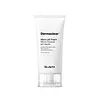What's inside
What's inside
 Key Ingredients
Key Ingredients

 Benefits
Benefits

 Concerns
Concerns

 Ingredients Side-by-side
Ingredients Side-by-side

Water
Skin ConditioningGlycerin
HumectantAcrylates Copolymer
Potassium Cocoyl Glycinate
Disodium Cocoamphodiacetate
CleansingPotassium Cocoate
EmulsifyingSodium Cocoyl Alaninate
Panthenol
Skin Conditioning1,2-Hexanediol
Skin ConditioningSodium Chloride
MaskingSodium Hydroxide
BufferingSodium Methyl Cocoyl Taurate
CleansingCaprylyl Glycol
EmollientZea Mays Starch
AbsorbentMicrocrystalline Cellulose
AbsorbentMannitol
HumectantButylene Glycol
HumectantGlycoproteins
Skin ConditioningHydroxypropyl Starch Phosphate
Hexylene Glycol
EmulsifyingSodium Phytate
Gluconolactone
Skin ConditioningEDTA
Tocopheryl Acetate
AntioxidantCI 77289
Cosmetic ColorantWater, Glycerin, Acrylates Copolymer, Potassium Cocoyl Glycinate, Disodium Cocoamphodiacetate, Potassium Cocoate, Sodium Cocoyl Alaninate, Panthenol, 1,2-Hexanediol, Sodium Chloride, Sodium Hydroxide, Sodium Methyl Cocoyl Taurate, Caprylyl Glycol, Zea Mays Starch, Microcrystalline Cellulose, Mannitol, Butylene Glycol, Glycoproteins, Hydroxypropyl Starch Phosphate, Hexylene Glycol, Sodium Phytate, Gluconolactone, EDTA, Tocopheryl Acetate, CI 77289
Water
Skin ConditioningGlycerin
HumectantLauric Acid
CleansingMyristic Acid
CleansingPotassium Hydroxide
BufferingStearic Acid
CleansingGlycol Distearate
EmollientPalmitic Acid
EmollientGlyceryl Stearate Se
EmulsifyingCitrus Aurantium Bergamia Fruit Oil
MaskingPelargonium Graveolens Flower Oil
MaskingCitrus Limon Peel Oil
MaskingOlea Europaea Fruit Oil
MaskingQuillaja Saponaria Bark Extract
CleansingSalvia Officinalis Oil
MaskingPogostemon Cablin Leaf Oil
MaskingPinus Sylvestris Leaf Oil
MaskingCitrus Aurantium Dulcis Oil
MaskingCitrus Grandis Peel Oil
MaskingSalvia Sclarea Oil
MaskingAniba Rosodora Wood Oil
AstringentLavandula Angustifolia Oil
MaskingCedrus Atlantica Bark Oil
MaskingEucalyptus Globulus Leaf Oil
PerfumingMilk Lipids
Skin ConditioningJasminum Officinale Oil
MaskingSea Salt
AbrasiveArtemisia Absinthium Extract
Skin ConditioningMyrtus Communis Oil
MaskingRosa Damascena Flower Oil
MaskingVanilla Planifolia Fruit Extract
Skin ConditioningFerula Galbaniflua Resin Oil
AntimicrobialCoco-Glucoside
CleansingPolyquaternium-7
Acrylates/C10-30 Alkyl Acrylate Crosspolymer
Emulsion StabilisingSodium Cocoyl Isethionate
Cleansing1,2-Hexanediol
Skin ConditioningCitric Acid
BufferingTheanine
EmollientGlutathione
Copaifera Officinalis Resin
MaskingDisodium EDTA
Sodium Benzoate
MaskingWater, Glycerin, Lauric Acid, Myristic Acid, Potassium Hydroxide, Stearic Acid, Glycol Distearate, Palmitic Acid, Glyceryl Stearate Se, Citrus Aurantium Bergamia Fruit Oil, Pelargonium Graveolens Flower Oil, Citrus Limon Peel Oil, Olea Europaea Fruit Oil, Quillaja Saponaria Bark Extract, Salvia Officinalis Oil, Pogostemon Cablin Leaf Oil, Pinus Sylvestris Leaf Oil, Citrus Aurantium Dulcis Oil, Citrus Grandis Peel Oil, Salvia Sclarea Oil, Aniba Rosodora Wood Oil, Lavandula Angustifolia Oil, Cedrus Atlantica Bark Oil, Eucalyptus Globulus Leaf Oil, Milk Lipids, Jasminum Officinale Oil, Sea Salt, Artemisia Absinthium Extract, Myrtus Communis Oil, Rosa Damascena Flower Oil, Vanilla Planifolia Fruit Extract, Ferula Galbaniflua Resin Oil, Coco-Glucoside, Polyquaternium-7, Acrylates/C10-30 Alkyl Acrylate Crosspolymer, Sodium Cocoyl Isethionate, 1,2-Hexanediol, Citric Acid, Theanine, Glutathione, Copaifera Officinalis Resin, Disodium EDTA, Sodium Benzoate
 Reviews
Reviews

Ingredients Explained
These ingredients are found in both products.
Ingredients higher up in an ingredient list are typically present in a larger amount.
1,2-Hexanediol is a synthetic liquid and another multi-functional powerhouse.
It is a:
- Humectant, drawing moisture into the skin
- Emollient, helping to soften skin
- Solvent, dispersing and stabilizing formulas
- Preservative booster, enhancing the antimicrobial activity of other preservatives
Glycerin is already naturally found in your skin. It helps moisturize and protect your skin.
A study from 2016 found glycerin to be more effective as a humectant than AHAs and hyaluronic acid.
As a humectant, it helps the skin stay hydrated by pulling moisture to your skin. The low molecular weight of glycerin allows it to pull moisture into the deeper layers of your skin.
Hydrated skin improves your skin barrier; Your skin barrier helps protect against irritants and bacteria.
Glycerin has also been found to have antimicrobial and antiviral properties. Due to these properties, glycerin is often used in wound and burn treatments.
In cosmetics, glycerin is usually derived from plants such as soybean or palm. However, it can also be sourced from animals, such as tallow or animal fat.
This ingredient is organic, colorless, odorless, and non-toxic.
Glycerin is the name for this ingredient in American English. British English uses Glycerol/Glycerine.
Learn more about GlycerinWater. It's the most common cosmetic ingredient of all. You'll usually see it at the top of ingredient lists, meaning that it makes up the largest part of the product.
So why is it so popular? Water most often acts as a solvent - this means that it helps dissolve other ingredients into the formulation.
You'll also recognize water as that liquid we all need to stay alive. If you see this, drink a glass of water. Stay hydrated!
Learn more about Water